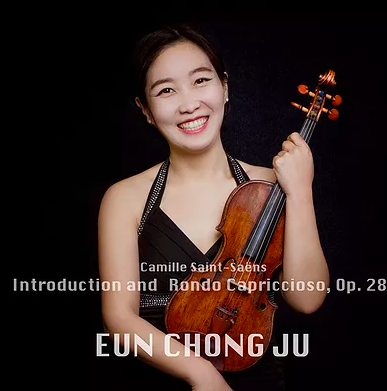Eun Chong Ju: Camille Saint-Saëns – Introduction and Rondo Capriccioso, Op. 28 in Review
Eun Chong Ju, violin
Min Kyung Kim, piano
Recorded at First Korean United Methodist Church, Main Chapel, Richardson, TX,
Oct 28, 2018
Korean born violinist Eun Chong Ju, with pianist Min Kyung Kim, recently released her recording of the Introduction and Rondo Capriccioso, Op. 28 by Camille Saint-Saëns. There are no physical copies available, but it is digitally available from iTunes, Spotify, and YouTube Music.
Composed in 1863 for Pablo de Sarasate (1844-1908), this work has been a mainstay of the violin repertoire ever since. It has become almost a mandatory showpiece for violinists to dazzle audiences with their virtuosity. Indeed, one can easily access performances of nearly every big-name (and not- so-big name) violinist. Millions of new listeners were introduced to this work after it was featured in an episode of the anime series Shigastu wa kimi no uso (Your Lie in April). It is thus reasonable for a listener to ask in what way another recording of such a warhorse can be differentiated from the others. In a way, a listener needs to put on “fresh ears” for each performance, and Ms. Ju’s recording is no exception.
This listener has always tried to judge live performances “in the moment” and to resist making too many comparisons to other performances; when the performances have been recorded, however, the listener ‘s expectation level is higher, given the opportunities for multiple takes and editing. Also, comparisons with other recordings are inevitable, though some of those comparisons are unhelpful or even misleading, such as the “Stopwatch” approach (Performance A lasted 1:43, Performance B lasted 1:39, often with the implication that “faster is better” when it may be the exact opposite!). Technique and tonal quality are fair game for comparison, but often the key differences are stylistic choices, in which the preference of the listener rules the day.
Now, with all that said, it is time to get to it. First, the positives: Ms. Ju is fearless in her approach; there is nothing tentative or lacking in commitment. There is a good amount of “swagger” where appropriate, and the pacing is effective. She does not try to gloss over difficult passages by increasing the tempo and sliding over the notes. The articulation is generally clean, and the ensemble is commendable.
Now, on to the negatives. In the effort to make every note heard, there is a certain heaviness that weighs down the rapid passages. One misses the light bounce bow work that one often hears in other performances. There are also some signs of straining, especially in the extreme upper register, along with some problems in the triple-stop section, with one particularly jarring moment. All this being said, these are issues that can certainly be addressed in future performances/recordings.
Ms. Ju is without a doubt a talented and promising musician. This recording shows that she is a work in progress, and I wish her the best in developing her talents and career.

